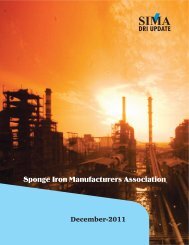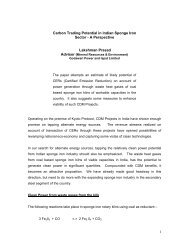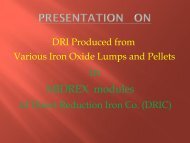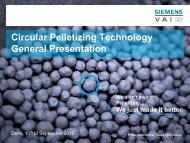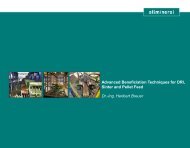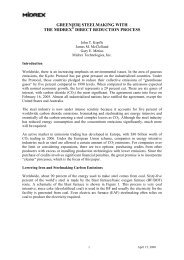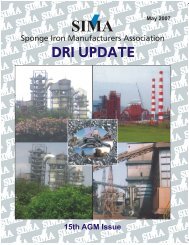sponge iron industry –past-present-future - SIMA
sponge iron industry –past-present-future - SIMA
sponge iron industry –past-present-future - SIMA
Create successful ePaper yourself
Turn your PDF publications into a flip-book with our unique Google optimized e-Paper software.
Figure I clearly depicts the break up of world<br />
<strong>sponge</strong> <strong>iron</strong> <strong>industry</strong> in 2009. It is clearly<br />
evident that the % share of gas based <strong>sponge</strong><br />
<strong>iron</strong> <strong>industry</strong> is much higher vis-à-vis coal<br />
based <strong>sponge</strong> <strong>iron</strong> <strong>industry</strong>. Globally gas<br />
based technology is prevailing and coal based<br />
<strong>sponge</strong> <strong>iron</strong> <strong>industry</strong> is primarily from India<br />
MIDREX – Technology – Gas based <strong>sponge</strong> <strong>iron</strong><br />
(mainly due to abundant availability of non<br />
coking coal).<br />
MAJOR SPONGE IRON TECHNOLOGY<br />
GAS BASED - MIDREX<br />
- HYL III / Energ<strong>iron</strong><br />
COAL BASED - SL / RN<br />
The MIDREX® Process consists of three major stages: 1) reduction, 2) reforming and 3) heat<br />
recovery.<br />
Reduction<br />
Iron oxide, in pellet or lump form, is introduced<br />
through a proportioning hopper at the top of<br />
the shaft furnace. As the ore descends through<br />
the furnace by gravity flow, it is heated and<br />
the oxygen is removed from the <strong>iron</strong> (reduced)<br />
by counter flowing gases which have a high<br />
H2 and CO content. These gases react with<br />
the Fe2O3 in the <strong>iron</strong> ore and convert it to<br />
metallic <strong>iron</strong>, leaving H2O and CO2. For<br />
production of cold DRI, the reduced <strong>iron</strong> is<br />
cooled and carburized by counter flowing<br />
cooling gases in the lower portion of the shaft<br />
furnace. The DRI can also be discharged hot<br />
and fed to a briquetting machine for production<br />
of HBI, or fed hot, as HDRI, directly to an EAF,<br />
as in the HOTLINK® System.<br />
Reforming<br />
To maximize the efficiency of reforming, off gas<br />
from the shaft furnace is recycled and blended<br />
with fresh natural gas. This gas is fed to the<br />
reformer, a refractory-lined furnace containing<br />
alloy tubes filled with catalyst. The gas is<br />
heated and reformed as it passes through the<br />
JANUARY-2011/15



